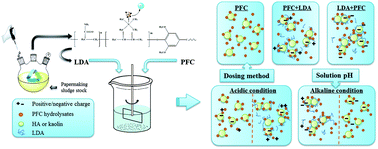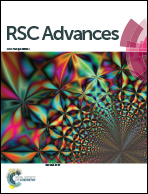Coagulation behavior and floc structure characteristics of cationic lignin-based polymer-polyferric chloride dual-coagulants under different coagulation conditions†
Abstract
To recycle papermaking sludge, a novel lignin-based flocculant with high cationic degree and molecular weight was introduced. The product, lignin–diallyl dimethyl ammonium chloride–acrylamide (LDA) was combined with polyferric chloride (PFC) to treat simulated humic acid (HA) solution. To identify its flocculation mechanisms, coagulation efficiencies and floc properties under different dosing methods and pH conditions were studied. Results showed that LDA was superior to polyacrylamide, poly diallyldimethylammonium chloride as well as lignin–acrylamide with regards to dissolved organic carbon (DOC) and turbidity removal efficiencies, which demonstrated its significant flocculating efficiency. Compared with single PFC, the addition of LDA enhanced the coagulation performance and floc properties, including floc size, growth rate and the recovery ability within the investigated pH range. The dosing sequence also had an effect on the coagulation mechanism and performance. When PFC was dosed first, negatively charged Fe(III) hydrolysates-colloids were neutralized and bridged by LDA. On the contrary, colloids–LDA complexes with slight negative charge were destabilized by the entrapment and sweeping effect of Fe(III) hydrolysates. As a result, coagulation efficiencies were in the following order: PFC dosed firstly (PFC + LDA) > LDA dosed firstly (LDA + PFC) > PFC. PFC + LDA achieved the maximum floc size and growth rate, whereas flocs with the most open structure was formed by LDA + PFC. Moreover, the effect of solution pH on coagulation behavior was noteworthy due to the variance of hydrolyzed Fe species. PFC was more sensitive to pH with regards to coagulation efficiencies and flocs structure. The variations caused by different pH values decreased after the addition of LDA. Regardless of the coagulant types, the optimal coagulation performance and floc characteristics were achieved under acidic conditions, especially at pH 6. Overall, LDA could introduce strong charge neutralization and adsorption bridging effect within a relatively wider pH range and offer a positive effect on coagulation behavior and flocs properties.


 Please wait while we load your content...
Please wait while we load your content...